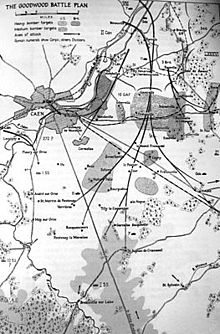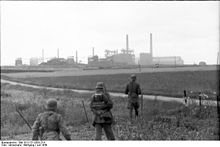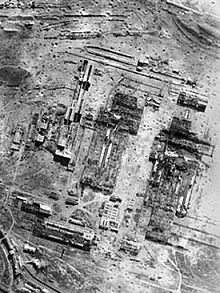- Operation Atlantic
-
Operation Atlantic Part of Battle for Caen Date July 18–21, 1944 Location Caen and surrounding area, France Result Southern Caen captured, further advances south repulsed Belligerents  Canada
Canada Germany
GermanyCommanders and leaders  Guy Simonds
Guy Simonds Günther von Kluge
Günther von KlugeStrength 2 Infantry Divisions
1 Armoured Brigade2 Panzer Divisions Casualties and losses 1,349[1][2] Unknown Operation Atlantic was a Canadian offensive during the Battle of Normandy in the Second World War, from July 18–21, 1944. This Canadian offensive was launched in conjunction with a British-led offensive, Operation Goodwood. Operation Atlantic was initially successful, with gains made on the flanks of the Orne River near Saint-André-sur-Orne, but an attack by the 4th & 6th Canadian Infantry Brigades against strongly defended German positions on Verrières Ridge resulted in heavy casualties and limited strategic gain.
Contents
Background
Further information: Invasion of Normandy and Operation OverlordThe historic Normandy town of Caen was a D-Day objective for the British 3rd Infantry Division that landed on Sword Beach on 6 June 1944.[3] The capture of Caen, while "ambitious", has been described by historian L F Ellis as the most important D-Day objective assigned to Lieutenant-General Crocker's I Corps.[nb 1] Operation Overlord called for Second Army to secure the city and then form a front line from Caumont-l'Éventé to the south-east of Caen, in order to acquire airfields and protect the left flank of the United States First Army while it moved on Cherbourg.[7] Possession of Caen and its surroundings would give Second Army a suitable staging area for a push south to capture Falaise, which could itself be used as the pivot for a swing right to advance on Argentan and then towards the Touques River.[8] The terrain between Caen and Vimont was especially promising, being open, dry and conducive to swift offensive operations. Since the Allied forces greatly outnumbered the Germans in tanks and mobile units, transforming the battle into a more fluid fast-moving battle was to their advantage.[9]
However hampered by congestion in the beachhead that delayed the deployment of its armoured support, and forced to divert effort to attacking strongly held German positions along the 9.3-mile (15.0 km) route to the town, the 3rd Division was unable to assault Caen in force, and was brought to a halt short of its outskirts.[10] Immediate follow-up attacks were unsuccessful as German resistance solidified; abandoning the direct approach, Operation Perch—a pincer attack by I and XXX Corps[11]—was launched on 7 June, with the intention of encircling Caen from the east and west.[12] I Corps, striking south out of the Orne bridgehead, was halted by the 21st Panzer Division,[13] and the attack by XXX Corps bogged down in front of Tilly-sur-Seulles, west of Caen, in the face of stiff opposition from the Panzer-Lehr-Division.[12] In an effort to force Panzer Lehr to withdraw or surrender,[14] and to keep operations fluid, the 7th Armoured Division pushed through a recently created gap in the German front line, and attempted to capture the town of Villers-Bocage.[15] The resulting day long battle saw the vanguard of the 7th Armoured Division withdraw from the town,[16] but by 17 June Panzer Lehr had themselves been forced back, and XXX Corps had taken Tilly-sur-Seulles.[17] A repeated attack from the 7th Armoured Division never materialised[18] and further offensive operations were abandoned when, on 19 June, a severe storm descended upon the English Channel. The storm, which would last for three days, significantly delayed the Allied build-up.[19] Most of the convoys of landing craft and ships already at sea were driven back to ports in Britain; towed barges and other loads (including 2.5 miles (4.0 km) of floating roadways for the Mulberry harbours) were lost; and no less than 800 craft were left stranded on the Normandy beaches until the next spring tides in July.[20]
Following the storm the next major offensive was launched. The attack, codenamed Operation Epsom, intended for VIII Corps to advance and capture the high ground near Bretteville-sur-Laize, to encircle Caen.[21] VIII Corps would strike, to the west of Caen, south across the River Odon and the Orne.[22] The attack was preceded by Operation Martlet[23] (also known as Operation Dauntless)[24] which, was to secure VIII Corp's flank by capturing the high ground on the right of their axis of advance.[23] Although the Germans managed to contain the offensive, to do so they had been obliged to commit all their available strength,[25] including two panzer divisions newly arrived in Normandy[26] and earmarked for a planned offensive against British and American positions around Bayeux.[27] Several days later Second Army launched a new offensive, codenamed Operation Charnwood, to gain possession of Caen.[28] Charnwood incorporated a postponed attack on Carpiquet, originally planned for Epsom as Operation Ottawa[29] but now codenamed Operation Windsor.[30] In a frontal assault the northern half of the city was captured.[28] However German forces still held possession of the city on the southern side of the Orne river including the Colombelles steel works,[31] which gave a unique observation post for artillery observers.[32]
Planning
On 10 July General Bernard Montgomery, commander of all Allied ground forces in Normandy, held a meeting with Lieutenant-Generals Miles Dempsey and Omar Bradley, respectively the commanders of British Second Army and the United States First Army, at his headquarters to discuss the next attacks to be launched by 21st Army Group[33] following the conclusion of Operation Charnwood and the failure of the First Army's initial breakout offensive.[34] Montgomery approved Operation Cobra,[35] a major break out attempt to be launched by the First Army on 18 July, and ordered Dempsey to "go on hitting: drawing the German strength, especially the armour, onto yourself - so as to ease the way for Brad[ley]".[33]
Detailed planning for Operation Goodwood stated on Friday 14 July[36] However on 15 July Montgomery issued a written order to Dempsey, scaling back the operation. These new orders changed the operation from a "deep break-out to a limited attack".[37] The intention of the operation was now "to engage the German armour in battle and "write it down" to such an extent that it is of no further value to the Germans" and improve the Second Army's position.[38] The orders stated that "a victory on the eastern flank will help us to gain what we want on the western flank" but warned that operations must not endanger Second Army's position as it was a "firm bastion" that was needed for the success of American operations.[39] It was stressed that II Canadian Corps objectives were now vital and only following their completion would VIII Corps ""crack about" as the situation demands".[39]
II Canadian Corps would launch an attack, codenamed Operation Atlantic, on the western flank of VIII Corps to liberate Caen south of the Orne river.[40] The Corps orders were issued the following day. The Canadians were ordered to liberate Colombelles and the remaining portion of Caen. Following the capture of these areas the Corps was to be prepared to capture the Verrières Ridge.[41] The Atlantic/Goodwood operation was planned to commence on 18 July, two days before the planned start of Operation Cobra.[42]
In-depth preparations for Atlantic were delegated to Lieutenant-General Guy Simonds of II Canadian Corp, his first action as the commander of the formation.[31] Simonds planned the operation as a two-pronged assault, relying on the 2nd and 3rd Canadian Infantry Divisions to capture Vaucelles, Colombelles, and the opposite banks of the Orne River.[31] On the morning of 18 July, the 3rd Division would cross the Orne near Colombelles, and then proceed south towards Route Nationale 158.[31] The 3rd Division would then move to capture Cormelles.[43] The 2nd Division, under the command of Charles Foulkes, would attack from Caen to the southeast, crossing the Orne to capture the outskirts of Vaucelles. They would then use Cormelles as a jumping-off point for an attack on the high ground near Verrières Ridge three miles to the south.
Orne Bridgehead
On the morning of July 20, with heavy aircraft support, advance elements of the 2nd Canadian Infantry were able to capture Colombelles & Faubourg-de-Vaucelles, a series of industrial suburbs just south of Caen along the Orne River. By mid-afternoon, two companies of the Black Watch were able to cross the Orne River, with A Company taking fewer than twenty casualties.[44] Additional Battalions from 5th Brigade managed to push southward to Saint-André-sur-Orne.[45] With the east bank of the Orne River secured, forces of the 4th and 6th Canadian Infantry Brigades moved into position for an assault on Verrières Ridge, preparing to engage a forces of the 12th and 1st SS Panzer Divisions along the slopes of Verrières Ridge.[46]
Assault on Verrières Ridge
During the Battle of Caen, forces of Sepp Dietrich's I SS Panzer Corps had turned the 90-foot (27 m) high ridge into their primary fortification, defending it with hundreds of guns, Tiger-tanks, rocket artillery, mortar-pits and infantry from up to three divisions.[47] As part of a minor follow-up to Operation Goodwood, The Calgary Highlanders had managed to establish preliminary positions on Verrières at Point 67, on the northern spur of the ridge.[48] On July 20, The South Saskatchewan Regiment, with support from The Queen's Own Cameron Highlanders of Canada and the Sherbrooke Hussars, as well as Hawker Typhoons, assaulted the ridge.[49] The Cameron Highlanders from Winnipeg attacked Saint-André-sur-Orne, but were pushed back by heavy German defences.[50] The main attack ran into torrential rain, rendering armour and aircraft useless and the infantry began to falter in the mud.[49] Without support, the South Saskatchewans lost 282 casualties in the face of tenacious German defenders.[51] In the aftermath of the South Sasks' failed assault, two German SS Panzer Divisions counterattacked, causing Canadian forces to retreat past their start-lines. The counterattack also heavily struck the supporting battalion, The Essex Scottish Regiment.[45][52] Over the remainder of the day, The Essex Scottish lost close to 300 casualties[45][53] On July 21, General Guy Simonds sent in The Black Watch (Royal Highland Regiment) of Canada and The Calgary Highlanders to stabilize the front along Verrières Ridge.[45] The two regiments, with support from the 3rd Canadian Infantry Division, were able to halt counterattacks by the two SS Panzer divisions, albeit with heavy casualties.[51]
Aftermath
1,349 Allied casualties were endured during Operation Atlantic the majority of them in the 4th and 6th Canadian Infantry Brigades.[2] The failure to seize Verrières Ridge resulted in Montgomery issuing orders on July 22 for another offensive, this time to be a "holding attack", within the next few days,[54] to be launched in conjunction with Operation Cobra. As a result, General Guy Simonds formulated the plans for Operation Spring. However, the contemporaneous Battle of Verrières Ridge claimed over 2,600 Canadian casualties by the end of July 26, 1944.[2]
Notes
- Footnotes
- ^ "The quick capture of that key city [Caen] and the neighbourhood of Carpiquet was the most ambitious, the most difficult and the most important task of Lieutenant-General J.T. Crocker's I Corps".[4] Wilmot states "The objectives given to Crocker's seaborne divisions were decidedly ambitious, since his troops were to land last, on the most exposed beaches, with the farthest to go, against what was potentially the greatest opposition."[5] However Miles Dempsey always considered the possibility that the immediate seizure of Caen might fail.[6]
- Citations
- ^ Copp, Fifth Brigade at Verrières Ridge, Pg. 5
- ^ a b c Zuehlke, Pg. 166
- ^ Williams, p. 24
- ^ Ellis, p. 171
- ^ Wilmot, p. 273
- ^ Buckley, p. 23
- ^ Ellis, p. 78
- ^ Ellis, p. 81
- ^ Van-Der-Vat, p. 146
- ^ Wilmot, pp. 284–286
- ^ Ellis, p. 247
- ^ a b Forty, p. 36
- ^ Ellis, p. 250
- ^ Ellis, p. 254
- ^ Taylor, p. 10
- ^ Taylor, p. 76
- ^ Forty, p. 97
- ^ Ellis, p. 255
- ^ Williams, p. 114
- ^ Wilmot, p. 322
- ^ Clark, pp. 31–32
- ^ Clark, pp. 32–33
- ^ a b Clark, p. 21
- ^ Ellis, p. 275
- ^ Hart, p. 108
- ^ Reynolds (2002), p. 13
- ^ Wilmot, p. 334
- ^ a b Williams, p. 131
- ^ Stacey, p. 150
- ^ Jackson, p. 60
- ^ a b c d Bercuson, p. 222
- ^ Trew, p. 53
- ^ a b Trew, p. 49
- ^ Wilmot, p. 351
- ^ Williams, p. 175
- ^ Jackson, p. 79
- ^ Trew, p. 66
- ^ Ellis, pp. 330–331
- ^ a b Ellis, p. 331
- ^ Stacey, p. 169
- ^ Stacey, pp. 170–171
- ^ Williams, p. 161
- ^ Roy, p. 68
- ^ Copp, The Approach to Verrières Ridge
- ^ a b c d Copp, Approach to Verrières Ridge
- ^ Jarymowycz, Pg. 3
- ^ Bercuson, Pg. 222
- ^ Copp, Fifth Brigade at Verrières Ridge, Pg. 2
- ^ a b Bercuson, Pg. 223
- ^ Canada at War, Operation Atlantic
- ^ a b Scislowski
- ^ Tank Tactics, Pg. 132
- ^ Bercuson, Pg. 224
- ^ Copp, Approach to Verrières Ridge
References
- Copp, Terry The Fifth Brigade at Verrières Ridge Laurier Centre for Military Strategic and Disarmament Studies.
- Copp, Terry The Approach to Verrières Ridge, Legion Magazine May/June 1999
- Zuehlke, Mark (2001). The Canadian Military Atlas. Stoddart. ISBN 0-77373-289-6.
- Bercuson, David [1996] (2004). Maple leaf Against the Axis. Red Deer Press. ISBN 0-88995-305-8.
- Jarymowycz, Roman. Der Gegenangriff vor Verrières German Counterattacks during Operation "Spring": 25–26 July 1944 (PDF). Laurier Centre for Military Strategic and Disarmament Studies.
- Jarymowycz, Roman. Tank Tactics, from Normandy to Lorraine. 2001 Lynne Rienner Publishers, ISBN 1555879500
- Scislowski, Stanley. Verrières Ridge - A Canadian Sacrifice (HTML). Maple Leaf Up. Retrieved on 2007-06-20
- Van-der-Vat, Dan D-Day, the Greatest Invasion, a People's History. 2004
External links
- Stacey, Colonel Charles Perry; Bond, Major C.C.J. (1960). "Official History of the Canadian Army in the Second World War: Volume III. The Victory Campaign: The operations in North-West Europe 1944–1945" (PDF). The Queen's Printer and Controller of Stationery Ottawa. http://www.dnd.ca/dhh/collections/books/files/books/Victory_e.pdf. Retrieved 2008-08-20.
Categories:- Military history of Normandy
- Battle for Caen
- Battles of World War II involving Canada
Wikimedia Foundation. 2010.



